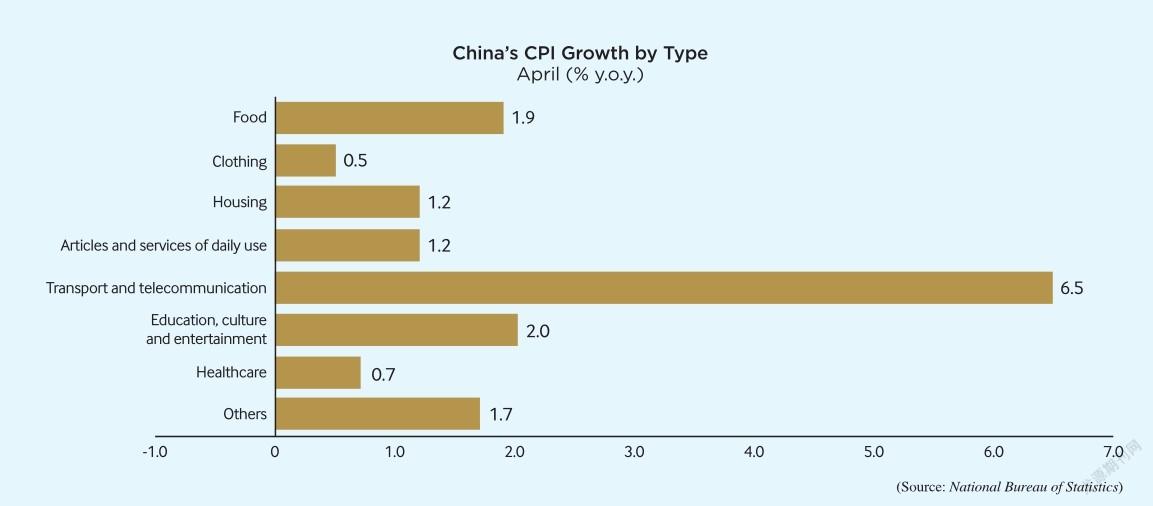TAKING OFF
2022-05-29

Chinas first C919 jetliner to be delivered takes off from Shanghai Pudong International Airport on May 14.
The aircraft, produced by state-owned manufacturer Commercial Aircraft Corp. of China (COMAC), flew for over three hours, according to Xinhua News Agency.
In March last year, China Eastern Airlines and COMAC signed a purchase contract for five C919 planes, which will be based mainly in Shanghai after delivery. To date, COMAC has received 815 orders for the C919 from 28 customers worldwide.
The C919 has 158-174 seats and a range of 4,075-5,555 km. The jetliner conducted its first successful test flight in 2017.
Better Lunches
Primary school students have lunch in Lhasa, Tibet Autonomous Region, on May 12. Thanks to the opening of a catering company in March, some 12,000 students in six primary schools in Chengguan District of Lhasa now enjoy a more balanced diet.

Higher Education Enrollment
The gross enrollment rate of Chinas higher education hit 57.8 percent in 2021, almost doubling the 30 percent in 2012, said the Ministry of Education (MOE) on May 17.
Over 44.3 million students are studying at higher education institutions across the country, the ministry told a press conference, adding that China now has the worlds largest higher education system.
A total of 240 million people in China have received higher education so far, according to the ministry.
Moreover, by the end of February 2022, China had more than 52,500 massive open online courses (MOOCs) with 370 million registered users, said Wu Yan, head of the higher education department under the MOE. More than 330 million college and university students have received MOOCs credits, Wu added.
Rare Golden Cat
A rare golden cat has been spotted in the city of Nagqu, Tibet Autonomous Region, Xinhua News Agency reported on May 16.
An Asian golden cat was captured by infrared cameras during a biodiversity survey project, which was jointly carried out by Nagqus forestry and grassland bureau and the Shan Shui Conservation Center.
It is the first time an image of the animal has been captured in the area.
The Asian golden cat is a national first-class protected animal and classified as “near threatened” by the International Union for Conservation of Nature on its Red List of Threatened Species.
A monitoring network with 197 infrared cameras was established under the project, covering 11 counties and districts of Nagqu.
“The appearance of the rare species is a testament to the improvement of the environment in the city,” said Mao Shiping, deputy director of the citys forestry and grassland bureau, adding that they will further strengthen the monitoring network and carry out long-term systematic research work.
News Media Development
In 2020 and 2021, omni-media and platform-based communication became a rising trend in Chinas news media industry, according to a report by the AllChina Journalists Association(ACJA), unveiled on May 16.
The report, titled Development of Chinas News Media, is the sixth of its kind from ACJA since 2014 and reviews new developments in the countrys news media sector in the era of deep convergence.
New media became an important growth point in the media industry. Citing statistics, the report noted that as of December 2021, the number of online news users had reached 771 million, increasing by 28.35 million from December 2020 and accounting for 74.7 percent of Chinas total Internet users.
Over the past two years, traditional media such as radio, television and newspapers have seen a slow pace of growth and continued to focus on deep convergence and digital transformation, the report noted.
According to the report, emerging technologies, such as media platforms, data transmission, high-definition video technology, artificial intelligence and 5G, have driven media reform and innovation.
“The media workforce in China is becoming younger and better educated, and more capable,” read the report.
Chinas news sector employed approximately 1 million employees, according to the report.
The report also noted that the past two years saw further efforts made by the ACJA in protecting journalists rights.
Rural Hypertension Control
Village doctor-led multifaceted intervention has resulted in significant improvements to blood pressure control among rural residents in China, according to a peer-reviewed medical journal article, Xinhua reported on May 16.
Sun Yingxian, a researcher at the First Hospital of China Medical University, and his team tested the effectiveness of a multifaceted intervention for blood pressure control conducted by village doctors in rural China. The testing was part of the first stage of China Rural Hypertension Control Project co-organized by a host of Chinese institutes and Tulane University.
Between May 8 and November 28, 2018, researchers recruited 33,995 individuals aged 40 or older and with high blood pressure from 326 villages that had a regular village doctor. The villages were designated at random to receive either village doctor-led multifaceted intervention or enhanced standard medical care.
The study concluded that village doctor-led intervention resulted in statistically significant improvements in blood pressure control in rural China. The findings have been published online in The Lancet.
Improved Environment
The scenery of the Hutuo River in Shijiazhuang, Hebei Province on May 16. Through the ecological restoration project that began in 2017, the river has now become a tourist attraction with picturesque scenery.

Water Diversion
The east and middle routes of Chinas South-to-North Water Diversion Project had transferred 53.1 billion cubic meters of water as of May 13, official data showed on May 14.
The project has replenished over 50 rivers with a total of 8.5 billion cubic meters of water, and replenished more than 5 billion cubic meters of overexploited underground water.
Over 140 million people in the north, including those in metropolises like Beijing and Tianjin, have relied on the project as a major source of water since 2014.
The South-to-North Water Diversion Project has three routes.
The middle route is the most prominent of the three due to its role in feeding water to the nations capital. It begins at the Danjiangkou Reservoir in Hubei Province and runs through Henan and Hebei before reaching Beijing and Tianjin. It began supplying water in December 2014.
The eastern route began operations in November 2013, transferring water from Jiangsu Province to areas including Tianjin and Shandong Province.
The western route is in the planning stage and is yet to be built.
At a meeting on May 13, Chinas Minister of Water Resources Li Guoying urged efforts to accelerate follow-up construction of the middle route and planning of the western route of the project.
Salt Harvest
Workers harvest salt in a salt field in Binzhou City of Shandong Province, on May 14.

Experimental Animals
China has officially published its first popular science book on experimental animals, the Science and Technology Daily reported on May 13.
The authors used poetry and paintings to summarize the scientific knowledge on domestication, evolution, cultivation and quality standardization of experimental animals in this book.
They also illustrated the contributions of experimental animals to major scientific discoveries. Popular issues such as life and health, animal welfare, biosafety and research ethics have also been discussed in this book.
The book was published by the Nanjing University Press.
Economic Performance
Chinas value-added industrial output, measuring factory activities, went up 4 percent year on year during the first four months of 2022, according to data released by the National Bureau of Statistics (NBS) on May 16.
Fixed assets investment jumped 6.8 percent, with investment in hi-tech industries soaring 22 percent.
Weighed down by the Omicron outbreak, retail sales of consumer goods, a significant indicator of consumption strength, went down 0.2 percent year on year in the January-April period.
The average surveyed urban unemployment rate stood at 5.7 percent during the four months, with some 4.06 million jobs created.
The countrys economy took a hit from the domestic resurgence of COVID-19 cases in April, but the impacts will be “short-lived,” Fu Linghui, a spokesperson for the NBS, said.
Net Forex Purchase
Chinese banks saw a net foreign exchange purchase in April, data from the State Administration of Foreign Exchange (SAFE) showed on May 17.
The banks bought $229.7 billion worth of foreign currencies and sold $210.6 billion worth in the month, resulting in a net purchase of $19 billion, the administration said.
“Despite the complicated external and domestic environment, China has continued to witness a net inflow of cross-border capital,”Wang Chunying, SAFEs deputy head, said.
Investment Projects
The National Development and Reform Commission (NDRC) announced on May 17 it approved 38 fixed assets investment projects worth 533.3 billion yuan ($78.6 billion) in the first four months of the year.
In April alone, eight projects were approved with the total investment of 18.8 billion yuan($2.8 billion), primarily in the information technology and energy sectors, according to NDRC spokesperson Meng Wei.
Fixed assets investment includes spending on infrastructure, property, machinery and other physical assets.
Investment has traditionally been a key engine for growth. In the face of COVID-19 flare-ups and increasing downward pressure on the economy, China has underlined the role of effective investment to bolster growth.
Courier Service
The courier sector reported a 4.2-percent increase in its business volume in the first four months of the year, official data showed on May 16.
Delivery service providers nationwide handled 31.71 billion parcels in the period, while business revenue of the sector gained 2.3 percent year on year to total 313.33 billion yuan ($46.17 billion), according to the State Post Bureau.
In April alone, delivery service providers saw their business volume and revenue down 11.9 percent and 10.1 percent, respectively, from a year ago.
Patent Applications
Chinese enterprises submitted 141 applications for the international registration of industrial designs in the first nine days after a related international treaty came into effect in China on May 5, China National Intellectual Property Administration (CNIPA) said on May 16.
The Hague Agreement Concerning the International Registration of Industrial Designs establishes a framework for the protection of intellectual property in 94 countries.
On May 5, 108 applications were submitted by 49 Chinese enterprises, Wei Baozhi, a CNIPA official, said at a press conference.
The CNIPA received 58 such applications on that day, with the number of applications from computer manufacturer Lenovo, healthcare tech company GEMT, and smartphone maker Xiaomi, topping the list, Wei added.
SDR Share
The share of the Chinese yuan in the International Monetary Funds(IMF) Special Drawing Rights (SDR) basket has risen from 10.92 percent to 12.28 percent, the Peoples Bank of China (PBC) said on May 15.
The SDR is an international reserve asset supplementing members official reserves, which can be exchanged among governments for freely usable currencies in times of need.
In 2016, the IMF included the yuan in its SDR basket as a fifth currency, along with the U.S. dollar, the euro, the Japanese yen and the British pound.
At present, the Chinese yuan ranks third in terms of the weight in the SDR basket, after the U.S. dollar and the euro.
The new SDR basket will come into effect on August 1 this year, according to the PBC.
China will continue to propel the reform and opening up of the financial market, creating a better environment for overseas investors, the bank said.
FDI Inflow
Paid-in foreign direct investment(FDI) into the Chinese mainland expanded 20.5 percent year on year to 478.61 billion yuan ($70.9 billion) in the first four months of the year, the Ministry of Commerce(MOFCOM) said on May 12.
In U.S. dollar terms, the inflow went up 26.1 percent year on year, according to the ministry.
The investment recorded double-digit growth on the high base of a 38.6-percent improvement in the same period last year, MOFCOM spokesperson Shu Jueting said.
The hi-tech industry logged a sharp year-on-year increase of 45.6 percent during the four months, up 25.1 percentage points from the average growth in all sectors.
FDI in the hi-tech manufacturing sector rose 36.7 percent from the same period last year, while that in the hi-tech services sector surged 48.3 percent, MOFCOM data showed.
During the January-April period, China saw 185 newly added major projects, each with foreign investment over $100 million, which means 1.5 major foreignfunded projects were launched on average each day.
FDI flowing into the countrys central region reported a yearon-year increase of 43.7 percent, followed by 26.9 percent in the western region and 18.7 percent in the eastern region.
Satellite Navigation
The total output value of Chinas satellite navigation and location services industry reached 469 billion yuan ($69.6 billion) in 2021, up 16.3 percent from the previous year, according to a white paper released by the Global Navigation Satellite System and Location Based Service Association of China on May 18.
China remained the top source of international satellite navigation patent applications last year, with a total of 98,000 applications, the report read.
Applications of the homegrown BeiDou Navigation Satellite System have been widely introduced into business fields and daily life, Sun Zhongliang, deputy head of the association, said, adding that mass consumption has become one of the major sectors for BeiDou applications.
Sun highlighted bike-sharing services, saying the number of shared bicycles equipped with a BeiDou positioning chip has reached 5 million in over 450 cities across the country.
NUMBERS
($1=6.7 yuan as of May 19)


